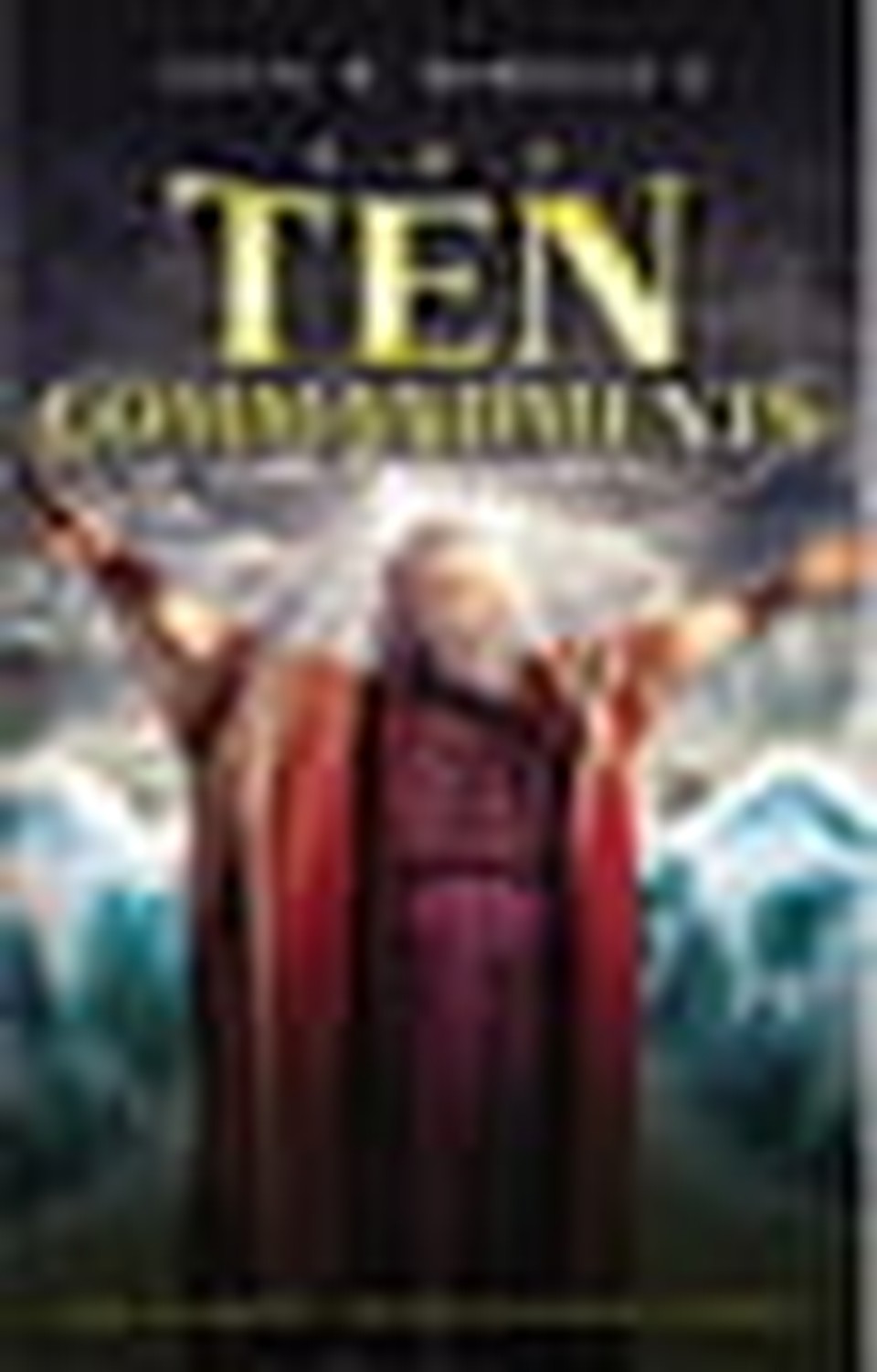Restored Ten Commandments Worth Another Look

DVD Release Date: March 29, 2011
Rating: G
Genre: Drama, Adaptation, Historical
Run Time: 231 min.
Director: Cecil B. DeMille
Actors: Charlton Heston, Yul Brynner, Anne Baxter, Edward G. Robinson, Yvonne De Carlo, Debra Paget, John Derek, Sir Cedric Hardwicke, Nina Foch, Martha Scott, Judith Anderson, Vincent Price, John Carradine
Released theatrically in 1956, The Ten Commandments is just one of those films that seems as old as dirt. And for those of us of a certain age, we have undoubtedly seen this movie countless times, as year after year it’s trotted out religiously by television networks to coincide with Holy Week and Easter.
However, now that the cinematic masterpiece (voted the tenth best film in the epic genre by the American Film Institute) has been fully restored and is available in high definition for the first time ever, it’s worth another look.
Certainly, I had remembered that The Ten Commandments was a little over-the-top and sometimes campy in its performances, but also considered one of the great achievements in filmmaking. At the time, its set in the desert of Beni Yousef (south of Cairo, Egypt) was said to be the largest constructed movie set in history. Going on to win the Academy Award for Best Visual Effects (also nominated for Best Cinematography, Best Costume Design, Best Film Editing, Best Picture and Best Sound), it was also the last film made by celebrated director Cecil B. DeMille (The Greatest Show on Earth, The King of Kings).
What I didn’t remember, however, were all of the creative liberties taken in the storytelling. While The Ten Commandments is largely from the book of Exodus 2, it also embellishes with extra-biblical works or legends (Philo and Josephus—ancient writings said to “inform the thirty years of Moses’ life”), thus adding numerous plot elements that are not found in the biblical narrative. But rather than spoil “the show,” they only served to draw me back to Exodus to read for myself the account of the life of Moses and his leading of the Israelites out of Egypt toward the Promised Land.
The Ten Commandments opens with a brief—and rare—on-screen narration by DeMille, originally recorded only for home-movie editions, who tells the viewer that this is “the story of the birth of freedom.” Despite the film’s nearly four hours in length, time flies in the formative years for Moses (Charlton Heston) as in the first scene he’s a Hebrew baby floating in a basket on the Nile and the next he’s all grown up as the Prince of Egypt. For now, though, the secret of his heritage is being kept by his adoptive mother Bithiah (Nina Foch) who is daughter of Pharaoh Seti (Sir Cedric Hardwicke). But her handmaiden Memnet (Judith Anderson) has hidden away Moses’ Hebrew blanket that surrounded him when he was discovered. Will she keep the secret as her mistress commands her to?
Those who have read the biblical account know that Moses’ heritage will see the light and play an important role in drawing him back to his people. But not before Moses is banished to the desert after he’s killed an Egyptian and is revealed as a Hebrew. After a harrowing journey, he ends up in Midian where he works as a shepherd, marries Sephora (Yvonne de Carlo) and hears from God on Mt. Sinai. He must return to his people and be their deliverer. “I will put my laws into their hearts,” God instructs from the burning bush. “And into their minds will I write them.”
Moses is changed both physically and spiritually, and upon his return from Mt. Sinai tells Sephora that “it is not by the sword that [God] will deliver his people, but by the staff of a shepherd.” Certainly this is a foreshadowing of deliverance from sin to come with the Great Shepherd of the Sheep.
Upon returning to Egypt, Moses confronts then-Pharaoh, Rameses II (Yul Brynner) and commands him to “let my people go.” When Pharaoh refuses to relent, only four of the ten biblical plagues are shown on-screen. But after the plague on the firstborn takes the life of his son, a broken Pharaoh tells Moses to take his people and leave. Viewers will breathe a sigh of relief once the former slaves have finally crossed the great Red Sea that has been miraculously parted by some old-school special effects (the water is said to have been filmed being poured into vast tanks, and then the film was played backwards to achieve the effect of two giant walls of water).
Scenes like this also reinforce the idea of a literal “cast of thousands” overseen by DeMille in a filmmaking era when CGI (computer-generated imagery) was not yet in existence and “people” could not just be created with the click of a mouse. Large crowd shots including real men, women, children, animals, wagons and chariots no doubt required extensive work to coordinate and choreograph.
The Ten Commandments skips over other segments of Exodus until arriving at Mt. Sinai again, where Moses meets with God and receives the Ten Commandments. But meanwhile, back at the Israelite camp, there’s discontent, there’s the making of a golden calf and then there’s debauchery. Upon his return, Moses pronounces God’s judgment upon the people for their sin. And the film fast-forwards once more to the end of an era of leadership—and the end of this cinematic epic—as Moses takes his leave and charges Joshua with bringing the Israelites into the Promised Land.
While perhaps not a first choice as a biblical educational tool for parents to use with children in terms of accuracy, The Ten Commandments is still an interesting film for adults to watch in a twenty-first century world when wayward times while waiting for Christ’s return no doubt echo that of the Israelites. That modern-day spiritual application, and respect for its achievements in filmmaking, still make The Ten Commandments a grand movie experience and a catalyst for deeper discussion even five-plus decades later.
CAUTIONS:
- Drugs/Alcohol: None, except for what could be wine consumed at gatherings.
- Language/Profanity: None.
- Sex/Nudity: Various male characters are shown bare-chested throughout, as was customary dress for some people groups in Bible times (Egyptian and Hebrew); Egyptian palace handmaids are shown bathing in short dresses; various female characters wear costumes that expose their midriffs; adults will pick up that Baka intends to keep Lilia for himself and implies that he will have his way with her (sexually)—and later Dathan holds the power of Joshua’s future (death or working in the mines) and uses that to coerce Lilia into becoming his mistress which she does of her own free will to save Joshua’s life.
- Violence/Intensity: In general, all scenes of violence (or intense moments) are mild in their portrayals. A woman is stuck beneath a stone; a man is whipped, a man is strangulated; Moses’ staff turns into a rattlesnake and Pharaoh’s magicians turn staffs into rattlesnakes as well; blood is wiped around a doorway with a cloth; ominous mist portrays the “death angel” when the plague on Egypt’s firstborn sons is enacted; wailing heard when death angel passes over; Pharaoh’s army is swallowed up in the Red Sea when it closes; soldiers and horses and are briefly shown flailing around underwater.
TWO-DISC DVD OR BLU-RAY SET - SPECIAL FEATURES:
- Presented in 1080p high definition with English 5.1 DTS-HD Master Audio, English 2.0 Surround Dolby Digital.
- Commentary by Katherine Orrison, Author of Written in Stone: Making Cecil B. DeMille’s Epic, The Ten Commandments
- Newsreel: The Ten Commandments Premiere in New York
- Theatrical Trailers: 1956 “Making of” Trailer/1966 Trailer/1989 Trailer
Originally published March 29, 2011.







